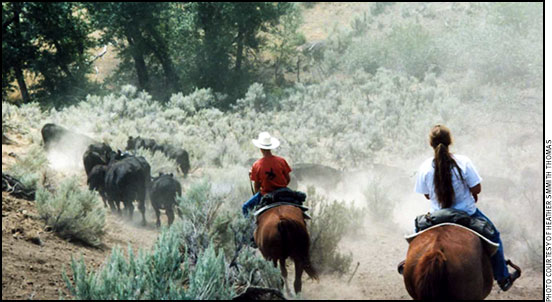
Dry Weather Increases Incidence of Respiratory Disease
Dry weather, smoke and dust this fall put calves at risk for respiratory disease.
Many areas of the country, including most of the western states, have seen an increase in respiratory problems in calves. Eugene Janzen, assistant dean of Clinical Practice, Veterinary Medicine at the University of Calgary, says there have been studies in western Canada in earlier years looking at this problem in cattle on community pastures. Often they have more trouble in dry years, when conditions are dusty when gathering and working cattle. Dust can irritate the respiratory tract, making the animals more susceptible to problems.
“I used to explain to my students that when calves inhale dust, the first line of defense in the respiratory tract may be easily overwhelmed. If the inside of the nostrils and upper respiratory tract get clogged with dust, then the bacteria are not as readily exposed to the nasal secretions, which tend to kill them or help flush them out. If bacteria cling to dust particles, they can be sucked down into the lungs,” says Janzen.
The dust and irritation also inhibit normal action of cilia — the tiny hair-like structures that line the windpipe and move in wave-like motions, continually moving mucus, dust and foreign material up and out of the respiratory tract to be coughed out.
“On dusty days, the respiratory system can be readily overwhelmed. You can measure this by the cowboys talking about increased treatment rates. Shortly after bringing the cattle in, if they had a bad year for dust, they are treating calves for pneumonia. Out of this experience a protocol for communal grazing systems was developed. If ranchers were planning to bring calves to those pastures, they were asked to vaccinate for certain diseases,” he explains.
Western Canada and many western states have suffered through a couple months or more of hot, dry conditions; smoke from catastrophic fires; dust; and stressful weather. In mountainous regions a combination of hot days (often up to 90° F or higher) and cool nights (often down in the 40s) added additional stress, which hinders the immune system — creating perfect conditions for respiratory disease.
A research group at Oklahoma State University recently examined pathological mechanisms of respiratory disease in cattle, and Janzen corroborates the findings with his own observations.
“Here in western Canada we’ve gone from seeing acute bacterial pneumonia to seeing more chronic respiratory problems. If we look at the cattle that die, most are suffering from a more chronic mix of pathogens. This is very different from what we were dealing with 40 years ago. When I grew up we could give a sick animal sulfamethazine and penicillin and it got better,” says Janzen.
Now the respiratory disease problem is much more complicated, and traditional treatments don’t work.
In the past, calves could be weaned and watched for about 10 days, or go to a feedlot pen with new cattle and be watched for four or five days, and then the highest risk of sickness — or epidemic curve — would be done. Bloat and feed-related issues could come up, but respiratory challenges weren’t a concern.
Now, he says, the incidence of respiratory disease drags on for weeks or months. As vigilance in a pen diminishes, or the mix of pathogens increases, there can be different kinds of pneumonia, and some are harder to detect.
“The mycoplasmas, for example, do not produce a toxin, so those animals don’t give us the benefit (for detection) by looking sick. The disease can be well-advanced before we realize the animal has a problem. By contrast, in earlier days, there might be a pathological lesion in the lungs, and if that was caused by an aggressive Mannheimia, the animal would be depressed and the ones that needed treatment were obvious. But those days, at least in western Canada, are gone. There are some regions where Mannheimia pneumonia is still fairly common, but we seem to have a different situation here,” he says.

Editor’s Note: Heather Smith Thomas is a cattlewoman and freelance writer from Salmon, Idaho.






